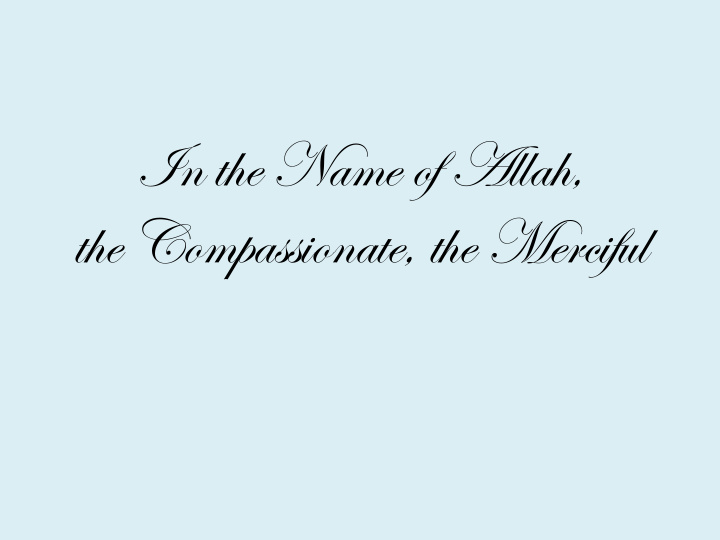



In the Name of Allah, the Compassionate, the Merciful
IRAN in UHC to PHC from
Prior to the Islamic Revolution The Health Care System • No proper national health care system • Acceptable hospital care only in a few major cities
• 12-14/000 Iranian physicians and around 3000 expatriates • Iranian physicians to population ratio: • Specialists scarce in some provinces • 65/000 villages with practically no public health provider
After the Islamic Revolution Increased expectations of people • Imam Khomeini’s (PBUH) demand • for “ Social Justice” Eight years of war (casualties and • damages)
• Economic pressures (oil prices), sanctions • Emigration of physicians • Shortage of health humanpower
A Major Decision • Expansion of the Primary Health Care System (1984)
• West Azerbaijan research project (1972-1976) • Community Health Workers called: Behvarz (local) • 2 years training at Behvarz Training Center, a boarding school in each city
Health Houses • Staffed by 2 Behvarzes (one female and one male) • Each covering 1,500 population • Main village and 3-4 satellites • Maximum one hour walking distance • Active services, based on 8 elements of PHC
Rural Health Centers • Staffed by physicians and variety of health technicians • Each Covering 5 health houses (total population of 7,500) • Functions: referral, information, supervision
Urban Health Centers Health posts (offering preventive health • care) Covering 12,500 population • Active services through Women Health • Volunteers (200,000 covering 2/3 of urban population)
District Health Centers • Education, research, support and supervising all health centers of the same district Provincial Health Center • Supervising all district health centers of the entire province • Its director is deputy to the chancellor of the provincial university
Major Events: • In 1985 the Ministry of Health and Medical Education was established • Universities of Medial Sciences and Health Services were established
Gradual Change for the Better a- Quantity b- Quality • Education • Research • Health Care and Management, such as integration of: mental health, IDD, polio eradication, T.B, and malaria control
1977 1984 2000 2008 2015 Mortality Neonatal 45 35 29 19 9.1 Under-five 130 60 36 22 15 Maternal 255 140 37 27 21 (1976) Life expectancy (Years) Female) 57 71 73.4 74.2 76.5 Male 57 67.7 70.7 71.1 74 Access to rural 20 90 95 97 PHC (%) 99 Access to safe drinking 71 95 98 (2012) water (%) Immunization coverage 99 20 95 99 (%) (2014) Safe delivery 70 81 92 99
Family Physician Program a-Rural areas and cities with less than 20,000 population • Financing through the health insurance • Run by 6,673 GPs and 5,370 midwives • A short virtual training (master degree) for some • Residency Program
b- Urban areas • Only in 2 provinces • Physicians , midwives and health experts as a team • Conducting census • Registering individuals up to a ceiling
Among the General Health Policies, endorsed by the Supreme Leader (May 2014), are: • Emphasizing on “ Health Equity” • Decreasing “ Out-of-Pocket” expenditure • Increasing public health expenditure
Health Reform Plan • Expanding population coverage of basic health insurance • Improving quality of care in public hospitals • Reducing out-of-pocket payments for in- patient services
• Adding diabetes and B.P. control to the previous PHC services • Expanding PHC services to the slum areas, and adding one expert in mental health and another one in nutrition • Updating relative value units of clinical services and tariffs
UHC In the simplest word, UHC is a system in which • everyone in society can get proper health-care services they need without incurring financial hardship. Former WHO director general says: UHC is • the single most powerful concept that public health has to offer. Nobel Laureate, Amartya Sen says: UHC is an • “affordable dream”.
Challenges Insufficient link between the community • and the local health facilities. The weak referral system. • The quality of health care is not desirable. •
Insufficient involvement of universities in • community participation and intersectoral collaboration. The medical curriculum is not community • oriented. The health insurance system is very • inadequate.
Induced demands and services are out of • control. Supervision and monitoring is not desirable. • Inequity in access and utilization of health • services is still a major challenge.
The services do not necessarily use the least • expensive delivery method. Although UHC needs more public funding, • however it first requires reducing wastes and improving efficiencies in service delivery.
As PHC is a foundational pillar of UHC, • PHC system needs to be: upgraded, o strengthened, o Become people-centered with emphasis o on the people who are marginalized, underserved and vulnerable.
o With much emphasis on SDH o Electronic information system, using disaggregated indicators regarding health equity.
Tha hank y nk you
Recommend
More recommend